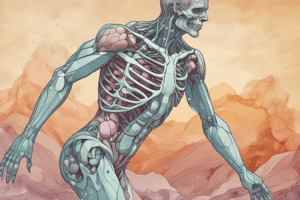Podcast
Questions and Answers
What are the major minerals in the body?
What are the major minerals in the body?
Sodium, Potassium, Phosphorus, Calcium (the most abundant), Magnesium, Chloride
What factors influence bioavailability of minerals?
What factors influence bioavailability of minerals?
Status of nutritional values, binders (oxalate, phytates), low food stores
Describe how mineral salts dissociate in water.
Describe how mineral salts dissociate in water.
Salts dissolve in water and dissociate into ions, both positive and negative ions.
What are ions?
What are ions?
What are cations and anions?
What are cations and anions?
If a mineral ion has a positive charge of 1, how many protons versus electrons does it have?
If a mineral ion has a positive charge of 1, how many protons versus electrons does it have?
What minerals are involved with growth and maintenance of bones?
What minerals are involved with growth and maintenance of bones?
List the functions of sodium in the body.
List the functions of sodium in the body.
How is sodium involved in fluid balance?
How is sodium involved in fluid balance?
Describe the mechanisms used to correct dehydration in the body.
Describe the mechanisms used to correct dehydration in the body.
From what sources do we obtain water in our diets?
From what sources do we obtain water in our diets?
Under what conditions do individuals experience sodium deficiency?
Under what conditions do individuals experience sodium deficiency?
What kinds of foods supply most of the sodium in our diets?
What kinds of foods supply most of the sodium in our diets?
Compare the average daily intake of sodium to the tolerable upper limit of sodium and discuss ways to decrease sodium levels in the diet.
Compare the average daily intake of sodium to the tolerable upper limit of sodium and discuss ways to decrease sodium levels in the diet.
How does high intake of sodium affect blood pressure and bone health?
How does high intake of sodium affect blood pressure and bone health?
Under what conditions do individuals experience sodium toxicity?
Under what conditions do individuals experience sodium toxicity?
List the functions of potassium in the body.
List the functions of potassium in the body.
Where is most of the potassium located in the fluid compartments of the body?
Where is most of the potassium located in the fluid compartments of the body?
How do potassium and sodium interact in muscle contraction and nerve transmission?
How do potassium and sodium interact in muscle contraction and nerve transmission?
List food sources of potassium.
List food sources of potassium.
Why do potassium levels decrease in foods that are processed with sodium?
Why do potassium levels decrease in foods that are processed with sodium?
Under what conditions do individuals experience potassium deficiency?
Under what conditions do individuals experience potassium deficiency?
Under what conditions do individuals experience potassium toxicity?
Under what conditions do individuals experience potassium toxicity?
Describe the functions of calcium in the body.
Describe the functions of calcium in the body.
Where is most of the calcium in the body found?
Where is most of the calcium in the body found?
Why is calcium in the blood strictly regulated within narrow limits?
Why is calcium in the blood strictly regulated within narrow limits?
Describe how the body maintains calcium levels in the blood.
Describe how the body maintains calcium levels in the blood.
List factors that increase calcium absorption.
List factors that increase calcium absorption.
List food sources of calcium.
List food sources of calcium.
Describe bone remodeling during growth, adulthood, and old age.
Describe bone remodeling during growth, adulthood, and old age.
Describe the effect of menopause on bone loss in women.
Describe the effect of menopause on bone loss in women.
What effect does lifelong inadequate intake of calcium have on the body?
What effect does lifelong inadequate intake of calcium have on the body?
Does dietary calcium influence blood calcium?
Does dietary calcium influence blood calcium?
Describe osteoporosis and its cause.
Describe osteoporosis and its cause.
What risk factors are associated with developing osteoporosis?
What risk factors are associated with developing osteoporosis?
How can an aging individual maintain his/her bone density with lifestyle?
How can an aging individual maintain his/her bone density with lifestyle?
What are the benefits and pitfalls of calcium supplementation?
What are the benefits and pitfalls of calcium supplementation?
How should one supplement with calcium for maximum absorption?
How should one supplement with calcium for maximum absorption?
What are the functions of magnesium and phosphorus in the body?
What are the functions of magnesium and phosphorus in the body?
List food sources for magnesium and phosphorus.
List food sources for magnesium and phosphorus.
Under what conditions can one experience a deficiency of magnesium or phosphorus?
Under what conditions can one experience a deficiency of magnesium or phosphorus?
Under what conditions can one experience a toxicity of magnesium?
Under what conditions can one experience a toxicity of magnesium?
Flashcards
What are the major minerals in the body?
What are the major minerals in the body?
Major minerals include sodium, potassium, phosphorus, calcium (most abundant), magnesium, and chloride.
How does bioavailability of Minerals get affected?
How does bioavailability of Minerals get affected?
Bioavailability of minerals is affected by factors such as nutritional status, the presence of binders like oxalates and phytates, and levels of food stores.
What happens when mineral salts dissolve in water?
What happens when mineral salts dissolve in water?
Salts dissolve in water, breaking down into positively charged ions (cations) and negatively charged ions (anions).
What are ions, cations, and anions?
What are ions, cations, and anions?
Signup and view all the flashcards
Which minerals are essential for bone health?
Which minerals are essential for bone health?
Signup and view all the flashcards
What are the functions of sodium in the body?
What are the functions of sodium in the body?
Signup and view all the flashcards
How does sodium regulate fluid balance?
How does sodium regulate fluid balance?
Signup and view all the flashcards
How does the body replenish lost sodium?
How does the body replenish lost sodium?
Signup and view all the flashcards
What are some dietary sources of water?
What are some dietary sources of water?
Signup and view all the flashcards
What are the causes and symptoms of sodium deficiency?
What are the causes and symptoms of sodium deficiency?
Signup and view all the flashcards
What are the major dietary sources of sodium?
What are the major dietary sources of sodium?
Signup and view all the flashcards
What are the recommended sodium intake levels?
What are the recommended sodium intake levels?
Signup and view all the flashcards
How does sodium intake affect health?
How does sodium intake affect health?
Signup and view all the flashcards
What are the symptoms of sodium toxicity?
What are the symptoms of sodium toxicity?
Signup and view all the flashcards
What are the functions of potassium?
What are the functions of potassium?
Signup and view all the flashcards
Where is potassium found, and how does it affect blood pressure and stroke risk?
Where is potassium found, and how does it affect blood pressure and stroke risk?
Signup and view all the flashcards
What are good sources of potassium?
What are good sources of potassium?
Signup and view all the flashcards
What are the causes and symptoms of potassium deficiency?
What are the causes and symptoms of potassium deficiency?
Signup and view all the flashcards
Can potassium toxicity occur, and if so, what are the symptoms?
Can potassium toxicity occur, and if so, what are the symptoms?
Signup and view all the flashcards
What are the essential functions of calcium in the body?
What are the essential functions of calcium in the body?
Signup and view all the flashcards
Where is most of the calcium in our body stored?
Where is most of the calcium in our body stored?
Signup and view all the flashcards
How are blood calcium levels regulated in the body?
How are blood calcium levels regulated in the body?
Signup and view all the flashcards
What factors influence calcium absorption?
What factors influence calcium absorption?
Signup and view all the flashcards
What are some good dietary sources of calcium?
What are some good dietary sources of calcium?
Signup and view all the flashcards
Explain bone remodeling and its importance.
Explain bone remodeling and its importance.
Signup and view all the flashcards
How does menopause affect bone health and what is the risk?
How does menopause affect bone health and what is the risk?
Signup and view all the flashcards
What are the consequences of long-term low calcium intake?
What are the consequences of long-term low calcium intake?
Signup and view all the flashcards
What is osteoporosis and what are the main causes?
What is osteoporosis and what are the main causes?
Signup and view all the flashcards
How can older adults maintain bone density?
How can older adults maintain bone density?
Signup and view all the flashcards
What are the benefits and drawbacks of calcium supplements?
What are the benefits and drawbacks of calcium supplements?
Signup and view all the flashcards
How can we maximize calcium absorption?
How can we maximize calcium absorption?
Signup and view all the flashcards
What are the functions of magnesium and phosphorus?
What are the functions of magnesium and phosphorus?
Signup and view all the flashcards
What are good sources of magnesium and phosphorus?
What are good sources of magnesium and phosphorus?
Signup and view all the flashcards
Are there any specific conditions that can lead to mineral deficiencies?
Are there any specific conditions that can lead to mineral deficiencies?
Signup and view all the flashcards
Can magnesium toxicity occur, and if so, how?
Can magnesium toxicity occur, and if so, how?
Signup and view all the flashcards
Study Notes
Major Minerals in the Body
- Major minerals include sodium, potassium, phosphorus, calcium (most abundant), magnesium, and chloride.
Bioavailability of Minerals
- Influenced by nutritional status, presence of binders like oxalates and phytates, and levels of food stores.
Dissociation of Mineral Salts in Water
- Salts dissolve in water, dissociating into positive and negative ions.
Ions, Cations, and Anions
- Ions are atoms or molecules with electrical charges, formed by gaining or losing electrons.
- Cations: positively charged ions; Anions: negatively charged ions.
- A cation with a charge of 1 has one more proton than electrons.
Minerals Supporting Bone Health
- Key minerals for bone growth and maintenance include phosphorus, calcium, and magnesium.
Functions of Sodium
- Maintains fluid and electrolyte balance and assists in nerve impulse transmission and muscle contractions.
Sodium and Fluid Balance
- Increased blood sodium levels trigger thirst, prompting fluid intake to restore sodium-water balance.
Dehydration Mechanisms
- Body replenishes lost sodium and water through diet; sodium levels drop require replacement through food.
Dietary Water Sources
- Sources include fruits, vegetables, meats, cheeses, and many beverages; recommended 8-12 cups (2-3 liters) daily.
Sodium Deficiency Causes and Symptoms
- Caused by vomiting, diarrhea, and heavy sweating. Symptoms include muscle cramps, mental apathy, and loss of appetite.
Dietary Sodium Sources
- Major sources are processed foods, table salt, soy sauce, meat, milk, bread, and certain vegetables.
Sodium Intake Recommendations
- Tolerable upper limit for sodium: 2,300 mg/day. Adequate intake varies by age (1,200-1,500 mg/day for different age groups).
Sodium's Impact on Health
- High sodium intake may increase blood pressure and lead to calcium loss, affecting bone health.
Sodium Toxicity Symptoms
- Prolonged excessive sodium intake can cause edema and acute hypertension.
Functions of Potassium
- Maintains fluid balance, supports reactions, aids in nerve impulses and muscle contractions.
Potassium's Role and Food Sources
- Most potassium is found inside body cells; higher sodium levels raise blood pressure, while potassium lowers stroke risk.
- Sources include meats, dairy, fruits, vegetables, whole grains, and legumes.
Potassium Deficiency Causes and Symptoms
- Symptoms: irregular heartbeats, muscle weakness, glucose intolerance, and increased blood pressure.
Potassium Toxicity Causes and Symptoms
- Can result from excessive supplementation; symptoms include muscle weakness and potential fatal heart issues.
Functions of Calcium
- Essential for mineralizing bones and teeth, muscle function, nerve functioning, blood clotting, and blood pressure regulation.
Calcium Location in the Body
- Most calcium is stored in the bones.
Regulation of Blood Calcium Levels
- Blood calcium levels must be tightly regulated to prevent negative effects like kidney stones. Parathyroid hormone and vitamin D play key roles.
Factors Influencing Calcium Absorption
- Increased absorption occurs with solubility; factors reducing absorption remain undefined in the text provided.
Calcium Food Sources
- Rich sources include milk, yogurt, and cheese.
Bone Remodeling
- Involves osteoblasts (bone-building) and osteoclasts (bone-resorbing) processes affecting bone health across age stages.
Menopause and Bone Loss
- Menopause leads to significant bone density reduction in women, influencing risk factors for osteoporosis.
Long-term Inadequate Calcium Intake
- May result in decreased bone density and potential impact on blood calcium levels.
Osteoporosis Overview and Risk Factors
- A condition marked by porous, fragile bones due to mineral loss, primarily caused by aging with various contributing factors.
Maintaining Bone Density in Older Adults
- Engaging in weight-bearing exercises such as jogging supports bone health.
Calcium Supplementation Benefits and Drawbacks
- Benefits: useful for lactose intolerant individuals. Pitfalls: possible heavy metal contamination and high intake risks.
Maximizing Calcium Absorption
- Recommended to take low doses of calcium between meals for optimal absorption.
Functions of Magnesium and Phosphorus
- Phosphorus: bone mineralization, energy metabolism, acid-base balance. Magnesium: supports bone health, enzyme activity, and nerve impulses.
Food Sources of Magnesium and Phosphorus
- Phosphorus is abundant in all animal tissue, while magnesium sources include nuts, legumes, whole grains, dark greens, and cocoa.
Conditions Leading to Mineral Deficiencies
- Phosphorus deficiency is rare, while magnesium deficiency may occur during alcohol abuse.
Magnesium Toxicity
- Rare but can be fatal, primarily resulting from excessive supplementation rather than food sources.
Studying That Suits You
Use AI to generate personalized quizzes and flashcards to suit your learning preferences.




